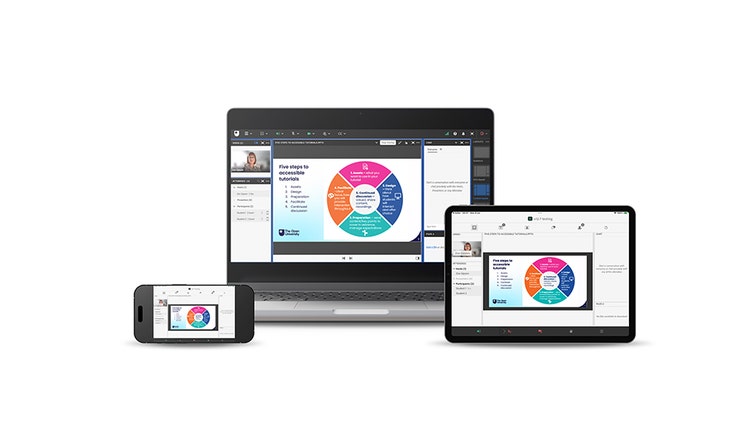
Engaging learners at massive scale.
The Open University expands online learning access for 200,000 students with Adobe Connect.


The Open University
Established 1969
Employees 10,000
Students 200,000
Milton Keynes, United Kingdom
www.open.ac.uk
Reseller partner: Collaborate
www.collab8.com
150%
Increase in live online learning events over four years
Products:

Objectives
Replace legacy conferencing tool with a more robust platform for live online education events
Grow course attendance while enhancing learning and reducing help desk tickets
Support all students with cross-device accessibility and an easy-to-use interface

Results
Created nearly 80,000 engaging learning events annually for 200,000 students, a 150% increase
Scaled to support 65 million online course meeting minutes, more than doubling growth
Ensured accessible, consistent, and smooth experiences for staff and students
A commitment to inclusive and high-quality distance learning
Lifelong education technology professional Zoe Gipson is committed to enhancing accessibility for all learners. In her nearly 20 years at the United Kingdom’s largest — and mostly online — university, she has promoted inclusive distance learning experiences.
Today, as Senior Product Development Manager at The Open University (OU), Gipson champions a culture of continuous improvement for the virtual learning platforms she oversees. However, an unexpected development in 2015 threatened to set back her efforts. The University used a web conference tool that the vendor no longer planned to support, including eliminating features that the OU used frequently. The task was set to find a tool that would not only ensure continuity of services but also provide richer capabilities to improve academic quality and student engagement.
Opening doors for more online learners
To start, the OU compiled a list of over 300 requirements for the new solution. It needed to integrate with the OU’s Moodle virtual learning environment and provide a high-quality academic experience on par with universities offering in-person coursework. The online environment needed to be easy for students and staff to use, providing positive experiences without overwhelming IT help desk staff with support requests.
The OU wanted to enhance accessibility with features like screen reader compatibility and keyboard access to aid the 26% of students with registered disabilities. The replacement solution also had to offer strong data protection, flexibility, and scalability to serve the University’s burgeoning enrollment.
After a competitive evaluation process, the OU chose Adobe Connect because it offered the best fit for its requirements while enabling greater student engagement. The University implemented the solution and trained its staff with the assistance of Collaborate, an Adobe Connect Platinum Partner. By working closely together on usability testing and monitoring, the team rolled out the platform university-wide in less than 18 months. Gipson and her team proactively set up templates for online course meeting spaces, saving time for faculty and promoting standardization of adult learning best practices.
The complexity of scheduling nearly 60,000 live, online learning events annually would seem daunting to most, but not for the OU. With meticulous planning enabled by Connect, the OU ensures that its 200,000 students, over 4,500 associate lecturers, and 5,500 academic, academic-related, and support staff can find their way to their scheduled and pre-configured tutorials and other events with ease.

“With Adobe Connect, our Associate Lecturers can utilise multiple Share pods simultaneously, such as displaying a slide deck in one pod while inputting annotations or equations in a second pod. You can’t do that with other similar products.”
Zoe Gipson, Senior Product Development Manager, The Open University
Advancing flexibility and standardization for academic events
To accommodate various teaching and learning approaches, thousands of rooms are set up in advance, using several layout templates that have been refined over time to establish a solid framework for academic sessions. The OU’s staff can customize the layouts to their particular needs in advance or on the fly.
“With Adobe Connect, our Associate Lecturers can utilise multiple Share pods simultaneously, such as displaying a slide deck in one pod while inputting annotations or equations in a second pod. You can’t do that with other similar products,” says Gipson. “Additionally, a bank of pods can be prepared in advance to deliver a smooth presentation, along with backup resources if a student asks a question. It allows for greater flexibility, and our lecturers can feel more in control.”
To boost student engagement, students and lecturers use multiple Chat pods within learning events. “Tutors and students can run more than one Chat pod at the same time, covering different topics, which makes it faster and easier to delve into various discussion themes,” Gipson says.
Tutors appreciate the platform’s rich capabilities to support teaching and learning. “I am not aware of a more robust system that is so well suited to delivering tutorials,” says one tutor at the OU.
Students notice the difference when it comes to accessibility. “I have a personal preference for Adobe Connect,” says one student at the OU. “It seems to work better with the assistive technology settings I have.”
Improving accessibility at scale
The new learning event platform has successfully fostered greater student attendance. In 2018, The OU used 11,000 Connect rooms and saw peak concurrency of 4,300 attendees. By 2022, the number of online rooms grew to 19,000, with peak concurrency of 6,000 attendees. Over four years, total course meeting minutes more than doubled to 65 million. By the opening day of the OU’s most recent academic session, the University topped one million minutes of live events in a single day, attended by 30,500 students across more than 2,000 sessions.

“It’s been invaluable to work with a supplier who takes the time to understand the granular requirements of the Open University and enhance its product accordingly.”
Scott Redrup, Senior Product Development Manager, The Open University
Gipson values ongoing improvements to the platform’s usability and accessibility, whether for mobile devices or laptops. For example, students can customize the text size and background color in Chat pods to improve readability. Gipson’s team also collaborated with Adobe on the early testing of captions for the desktop and mobile versions of Connect.
“Adobe welcomed our input on the importance of being able to move captions around so that they don’t block other important elements students also want to see,” says Gipson.
Gipson’s colleague Scott Redrup, Senior Product Development Manager at the OU, added, “It’s been invaluable to work with a supplier who takes the time to understand the granular requirements of the Open University and enhance its product accordingly.”
Promising AI-powered capabilities
Gipson sees Adobe as a strong, key partner to the OU. “We’re excited about upcoming AI-powered features in Adobe Connect, such as diarized transcripts. These capabilities will make tutorials and associated recordings more user-friendly and accessible for our students,” Gipson says. “I’m always eager to make the most of new features Adobe introduces so that we can continue to provide even better learning experiences.”

